If you are searching for “Hornbeam Tree Pros and Cons”, before that let me tell you Deciduous hornbeam trees (Carpinus spp.) are imposing trees that are a part of the Betulaceae family. They are well-known for their robust wood, stunning beauty, and ability to provide shade to both humans and wildlife. However, hornbeams have their share of benefits and drawbacks, just like any other tree species. The pros and cons of hornbeam trees will be discussed in this article, along with their advantages and challenges. This thorough guide will provide you important information, whether you’re contemplating growing a hornbeam tree in your yard or you’re just interested about these gorgeous trees.
| Pros | Cons |
|---|---|
| Strong wood for making tools, bowls, and dishes | Relatively slow growth rate |
| Highly resistant to pests and diseases | Difficult to transplant due to deep, spreading roots |
| Provides top-quality shade for humans and wildlife | Challenging to work with for carpenters |
| Beautiful appearance in all seasons, suitable for gardens | Not well-adapted to drought conditions |
| Tendency to form multiple trunks |
Pro: Strong Wood
The wood obtained from hornbeam trees is well-known for its exceptional strength and resilience, making it a favored material for various applications throughout history. With a solid and firm composition, hornbeam wood is particularly ideal for crafting tools, bowls, and plates. Carpenters and woodworkers admire its durability and sturdiness, allowing them to produce long-lasting goods. Moreover, its robust grain and high resistance to abrasion make it perfect for outdoor structures like posts and fences, as they can withstand harsh weather conditions.
Hornbeam wood’s strength and longevity have made it a popular choice for crafting tool handles such as axes, hammers, and chisels. Craftsmen often prefer using this wood due to its ability to endure heavy usage without breaking or splintering. As a result, these tools remain intact and maintain their structural integrity, enhancing both efficiency and safety during work.
The fine grain and smooth texture of hornbeam wood also lend themselves well to the creation of elaborate wooden bowls and platters. Woodworkers can shape these items with precision, resulting in aesthetically pleasing and functional pieces. The narrow pores of the wood further contribute to its suitability for food preparation and serving tools, as they prevent liquids from leaking through, ensuring the integrity of the dish.
Not limited to tool handles and tableware, hornbeam wood finds extensive use in outdoor construction. Its strong grain and exceptional resistance to abrasion make it an excellent choice for crafting posts and fences, providing reliable support in various outdoor environments. The wood’s durability ensures that these structures withstand the test of time, resisting decay and remaining resilient against natural elements.
Throughout history, hornbeam wood has played a significant role in the construction of various buildings and structures. Recognizing its strength, ancient civilizations incorporated hornbeam into their architecture and engineering projects. Temples, barns, and bridges have all benefited from the enduring qualities of hornbeam wood, standing as a testament to its long-lasting performance.
In addition to its practical applications, hornbeam wood has also found its way into cultural and artistic expressions. It has been intricately carved and used in ornamental elements of traditional architecture in certain regions. Furthermore, sculptors and artists value the wood’s ability to hold intricate details, making it a preferred medium for creating statues, figurines, and decorative artwork.
The historical significance of hornbeam wood extends into folklore and traditional beliefs as well. In some cultures, the hornbeam tree is associated with attributes such as strength, resilience, and protection. The wood has been used to craft talismans and amulets believed to bring good fortune and ward off negative energies.
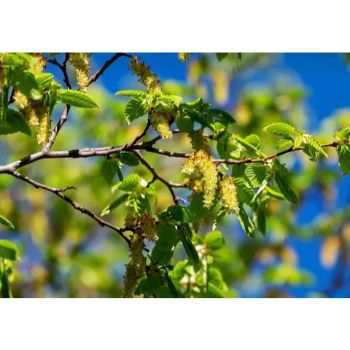
Notably, hornbeam trees are native to various parts of Europe, Asia, and North America, making this exceptional wood readily available in these regions. Its sustainable growth and quick regeneration have contributed to its popularity as an environmentally friendly choice for woodworking over the centuries.
As technology and woodworking techniques continue to advance, the admiration for hornbeam wood remains unchanged. Modern craftsmen and artisans continue to appreciate its unique properties and explore innovative ways to incorporate it into contemporary designs. The enduring legacy of hornbeam wood continues to shape our material culture, connecting us to the rich heritage of woodworking traditions that have relied on its strength and resilience for countless generations.
Pro: Resistant to Pests
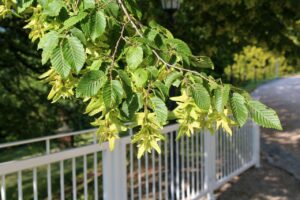
Hornbeam trees owe their natural resistance to pests and diseases to the chemical elements present in their bark and leaves. These substances act as powerful deterrents, making the tree less attractive to harmful insects and diseases. Consequently, issues such as aphid infestations, fungal infections, and leaf spot are significantly less likely to affect hornbeam trees. This inherent defense mechanism not only lowers the necessity for pest management practices but also ensures the tree’s general health and longevity.
In the realm of horticulture and tree care, the ability of hornbeam trees to resist pests and diseases is a considerable advantage. Gardeners and arborists often face challenges in combating various pests that can harm trees and lead to a decline in their well-being. Conventional solutions often involve the use of chemical pesticides, which can have detrimental effects on the environment and other organisms. However, with hornbeam trees, the reliance on harmful chemicals is minimized, leading to a more eco-friendly approach to tree care.
The reduced dependence on chemical pesticides not only benefits the immediate environment but also contributes to a healthier ecosystem overall. Pesticides, when used extensively, can harm beneficial insects, birds, and other animals that play essential roles in maintaining the natural balance of the ecosystem. By opting for hornbeam trees in landscapes and gardens, gardeners and arborists can create a more sustainable and harmonious environment, supporting biodiversity and ecological well-being.
Furthermore, the robust nature of hornbeam trees results in lower maintenance requirements. While other trees may necessitate regular applications of pesticides and various treatments to combat pests and diseases, hornbeams can largely thrive on their own. This resilience is particularly advantageous in large landscapes or natural settings where constant monitoring and interventions are impractical. As a result, hornbeam trees can be a low-maintenance yet rewarding addition to various environments, from private gardens to public parks.
The natural resistance of hornbeam trees to pests and diseases also contributes to their longevity and overall health. By avoiding the detrimental effects of infestations and diseases, these trees can grow and flourish for many decades, serving as steadfast and enduring elements of the landscape. Their sturdy presence provides habitat and sustenance for various wildlife species, further enhancing the ecological balance in the area.
Hornbeam trees have long been celebrated for their strength and durability in different cultural and historical contexts. They have played significant roles in folklore and traditional beliefs, symbolizing resilience and protection. In some cultures, hornbeam trees were regarded as guardians of the forest or sacred trees with potent spiritual qualities. This reverence for the tree’s ability to withstand adversity and thrive under challenging circumstances has contributed to its widespread popularity and cultivation across different regions.
Additionally, the aesthetic appeal of hornbeam trees enhances their desirability in landscaping and urban planning. The dense foliage and finely textured leaves create an elegant and sophisticated appearance that complements various architectural styles. Hornbeams are often used to line avenues, create hedgerows, or add structure to formal gardens. Their ability to resist common pests and diseases ensures that they maintain their beauty and vitality, adding value to the surrounding landscape for years to come.
Pro: Best Shade
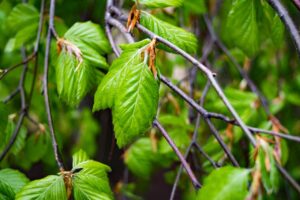
The hornbeam is the ideal tree to choose if you’re looking for great shade. It is the perfect option for establishing cool, cozy areas in your garden or outdoor area because to its wide canopy and thick leaves. Hornbeam trees provide shade, which is advantageous for both humans and wildlife seeking shade from the sun. As a result of the lush vegetation providing cover for birds, squirrels, and other small creatures, your surroundings are more biologically diverse and have a vibrant ecology.
The thick, layered foliage of hornbeam trees shades the ground below, keeping it cool. This is especially advantageous in the summer, when the shade lowers temperatures and shields people from the heat. Additionally, hornbeam trees’ extensive shade shields sensitive plants from intense heat, protecting them from withering or being burnt.
Hornbeam trees not only give shade but also habitat and protection for several wildlife species. Birds may construct their nests and nurture their young in a secure and sheltered environment thanks to the lush foliage and strong branches that create perfect nesting locations. Other tiny animals drawn to hornbeam trees by their shade and protection include squirrels and chipmunks, who may hide amid the branches.
Additionally, the presence of shade trees like hornbeams may contribute to the development of a favorable microclimate that supports a wide variety of plants and insects. Shade encourages the development of plants that like shade and provides cooler, more humid conditions that stimulate the growth of helpful insects like bees and butterflies. This in turn helps maintain the ecosystem’s general balance and vitality.
Pro: Suitable for Gardens
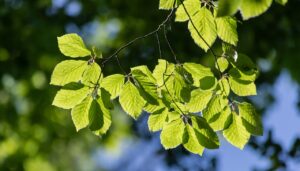
Hornbeam trees are a great option for garden landscapes because of their absolutely exceptional visual appeal. The tree’s explosion of vivid green leaves in the spring creates a cheery and dynamic ambiance. The leaves become a rich, deep green in the summer, creating a thick canopy of shade. The hornbeam adds a touch of warmth and charm to any garden as fall approaches with its spectacular display of golden yellow or flaming orange foliage. Even in the dead of winter, the tree exudes beauty thanks to the fine, silvery-gray bark that covers its limbs and elegantly stands out against the background of a snowy landscape.
Hornbeam is a fantastic addition to any garden or outdoor area because of its spectacular look throughout the seasons. In the spring and summer, its vivid green foliage produces a rich and welcoming ambiance that makes a lovely background for outdoor activities and events. The hornbeam’s leaves change into warm, alluring colours as autumn draws near, bringing a touch of drama and color to the scene. The hornbeam’s silver-gray bark shows out even in winter, when many trees seem naked and inactive, and creates an eye-catching contrast against the winter surroundings.
The hornbeam’s aesthetic appeal goes beyond only its leaves and bark. The tree’s distinctive growth pattern and very thick and symmetrical branches contribute to its allure. It has an attractive and structured design that blends well with both formal and casual garden settings. Gardeners and landscape architects like the hornbeam because to its adaptability and attractive features.
Con: Slow Growth Rate
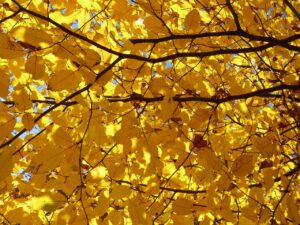
The comparatively sluggish development rate of hornbeam trees in comparison to other tree species is one of their key disadvantages. While some gardeners choose slower-growing trees for their durability and stability, others could find the slower pace annoying, especially when looking for quick results in landscaping or garden design projects. When choosing hornbeam trees, it’s crucial to consider both the end goal and the time frame, since they may take many years to achieve their maximum height and canopy spread.
There are a number of reasons behind hornbeam trees’ delayed development. First of all, hornbeams use a lot of energy building a solid and powerful root system, which is crucial for the stability and general health of the tree. Slower above-ground growth may be the consequence of the early years’ emphasis on root development. Additionally, hornbeam trees focus their energy on creating thick wood, which adds to their strength but also causes them to develop more slowly.
Although the slow growth rate may be considered a drawback in certain circumstances, it is important to remember that slower-growing trees often live longer and are typically more hardy. Hornbeam trees are able to adapt and develop robust root systems as a result of their slow and steady development, which increases their resilience to adverse weather and other environmental challenges.
Con: Deep Roots
Since hornbeam trees have extensive and deep root systems, transplanting them may be difficult. The resilience of the tree and its ability to acquire water and nutrients from the soil are both aided by these deep roots. But they also make hornbeam tree transplantation more difficult and sensitive than it is for trees with shallower root systems.
Hornbeam trees are securely rooted in the ground because to their extensive, deep roots, which also provide them the ability to sustain themselves structurally. These roots go far down into the ground, providing the tree with a solid base. This causes challenges when trying to transplant mature hornbeam trees, despite being beneficial for the tree’s general health and resilience.
Consider the size and scope of the hornbeam tree’s root system before transplantation. It is difficult to remove the tree without damaging the large root system because of this. To guarantee the effective transfer of the tree, the procedure calls for meticulous preparation, specific tools, and expert procedures.
A further characteristic of hornbeam trees is the development of taproots, which are long, thick roots that extend downward vertically. The existence of taproots makes the transplanting procedure much more difficult since they might be difficult to cut or remove without significantly stressing the tree.
It is best to transplant hornbeam trees while they are young or during their dormant season to enhance the likelihood of a successful transplant. Younger trees are simpler to handle and transplant since they have smaller root systems. The danger of damaging the roots is lower when transplanting during dormancy, when the tree is not actively developing, and the tree may concentrate its efforts on root reestablishment.
After translocation, the hornbeam tree has to be given the appropriate care and attention. The rehabilitation of the tree and its long-term life depend on adequate watering, mulching, and shelter from adverse weather.
Con: Challenging
One of the main hurdles carpenters face when working with hornbeam wood is its dense nature. Unlike softer woods, cutting and shaping hornbeam demands greater precision and force. Standard hand tools may prove inadequate, leading to laborious and time-consuming tasks. Additionally, the hardness of the wood can cause cutting blades to dull quickly, resulting in less efficient work and rough surfaces on the finished product. To address this, carpenters must either regularly sharpen their tools or use specialized equipment designed for handling dense and rigid wood like hornbeam.
Another challenge lies in the grain pattern of hornbeam wood, which is thick and tightly packed. This characteristic makes the wood less forgiving during shaping and carving, necessitating meticulous care and accuracy. Any mistakes or slips of the tool can significantly impact the final outcome, making it essential for carpenters to develop steady hands and precise techniques.
Despite these difficulties, the unique properties of hornbeam wood continue to attract carpenters and woodworkers due to its exceptional strength and resistance to wear. Its durability makes it an excellent choice for projects requiring longevity and endurance. When crafted with the right tools and methods, hornbeam wood showcases its inherent beauty and robustness, elevating furniture, flooring, and ornamental objects to a new level of elegance and quality.
To overcome the challenges associated with hornbeam wood, carpenters must employ various strategies. Selecting appropriate tools and equipment is crucial, including durable cutting tools like carbide-tipped blades that can handle the density and hardness of the wood. Power tools equipped with suitable attachments, such as band saws and routers, can significantly enhance efficiency and precision.
Moreover, careful planning and precise measurements are essential when working with hornbeam wood. Carpenters must mark and outline the design accurately before making any cuts to minimize wastage of material. Understanding and analyzing the wood’s grain pattern can also aid in determining the best approach for shaping and carving.
In addition, proper moisture control techniques are vital for dealing with hornbeam wood. Due to its density, the wood may be prone to splitting and cracking if not appropriately dried or acclimatized. Storing the wood in a controlled environment and ensuring it reaches the ideal moisture content will help minimize potential issues during the crafting process.
While working with hornbeam wood requires extra effort and attention to detail, the final results are undoubtedly rewarding. Its unique combination of strength and aesthetic appeal sets hornbeam wood apart from other options, making it a favorite choice for high-quality, long-lasting creations.
Con: Not Well-Adapted
Hornbeam trees have specific requirements for their growth and health, and one of the crucial factors is water availability. They are not well-suited to drought conditions and prefer damp soil with regular rainfall. In arid or dry areas, hornbeam trees may encounter challenges due to limited water supply, leading to stunted growth, wilting leaves, and increased vulnerability to pests and diseases.
During dry spells, hornbeam trees may exhibit signs of stress, such as drooping leaves, leaf loss, and reduced vitality. In such conditions, providing additional irrigation becomes essential to preserve the health of the trees, particularly during prolonged dry periods. Proper mulching around the tree’s base can help retain soil moisture and minimize evaporation.
Before planting hornbeam trees, it is crucial to consider the local climate. In regions prone to droughts or with limited water supply, selecting tree species that are more resistant to drought can be a wise decision. These drought-resistant trees can thrive in such environments and require less water to sustain their growth.
When grown in their natural habitat, hornbeam trees are typically found in areas with adequate rainfall and well-draining soil, ensuring they receive the necessary water for their optimal development. However, in dry or arid regions, providing supplemental water is essential to support their health and growth. Care must be taken not to overwater the trees, as excessive irrigation can lead to waterlogged soil and other problems.
Mulching around the base of the hornbeam trees can aid in soil moisture conservation. Mulch acts as a protective layer, reducing evaporation and helping the soil retain moisture for a longer duration. Organic mulch, like wood chips or bark, can also improve soil structure and fertility as it breaks down over time.
Con: Multiple Trunks
The propensity of hornbeam trees to sprout many trunks is one of their traits. When a tree sprouts new shoots from the base or lower portions of the trunk, the process is known as multi-stemming or coppicing. The multi-trunk look of hornbeam trees might be aesthetically pleasing to certain gardeners, but it can also provide challenges in some circumstances.
A growth pattern that is thick and congested due to the formation of many trunks might result in competition for resources like sunshine, water, and nutrients. Because certain trunks may dominate and restrain the development of others, this may have an impact on the general health and growth of the tree. Monitoring and controlling the growth of many trunks is crucial to ensuring balanced development and avoiding structural problems.
Additionally, having many trunks might complicate trimming and upkeep. To preserve healthy shape and form, each trunk has to get personalized attention and care. To promote air circulation and lower the danger of illness or breakage, regular pruning is required to remove any weak, crossing, or crowded branches. To maintain the tree’s general health and aesthetic appeal, repeated trunk pruning demands expertise and understanding.
It may be essential to remove a few of the extra trunks to promote a dominating central leader if you want a single-stemmed tree or have a small plot. To prevent placing an undue amount of stress on the tree, proceed slowly and gently.
Conclusion
To sum up Hornbeam Tree Pros and Cons, hornbeam trees provide a lot of benefits, including robust wood, resistance to pests and diseases, good shade production, and stunning beauty throughout the year. However, it’s crucial to note the slower growth rate, transplanting challenges, difficulty dealing with wood, susceptibility to dry conditions, and propensity to produce many trunks. You can decide if hornbeam trees are suitable for your particular gardening or landscaping requirements by being aware of both their pros and cons. Hornbeam trees, which provide beauty, shade, and long-lasting resilience, may be a wonderful addition to any outdoor area with the right care and attention.
Related Posts:
October Glory Maple Tree Pros And Cons – 9 Amazing Facts
Black Gum Tree Pros and Cons – 13 Facts You Need to Know
Redbud Trees Pros and Cons – 12 Facts You Need to Know
Chinese Pistache Tree Pros and Cons – 8 Facts You Need to Know
Jacaranda Tree Pros and Cons – 10 Facts You Need to Know
Zelkova Tree Pros and Cons: 7 Facts You Need to Know
references:
